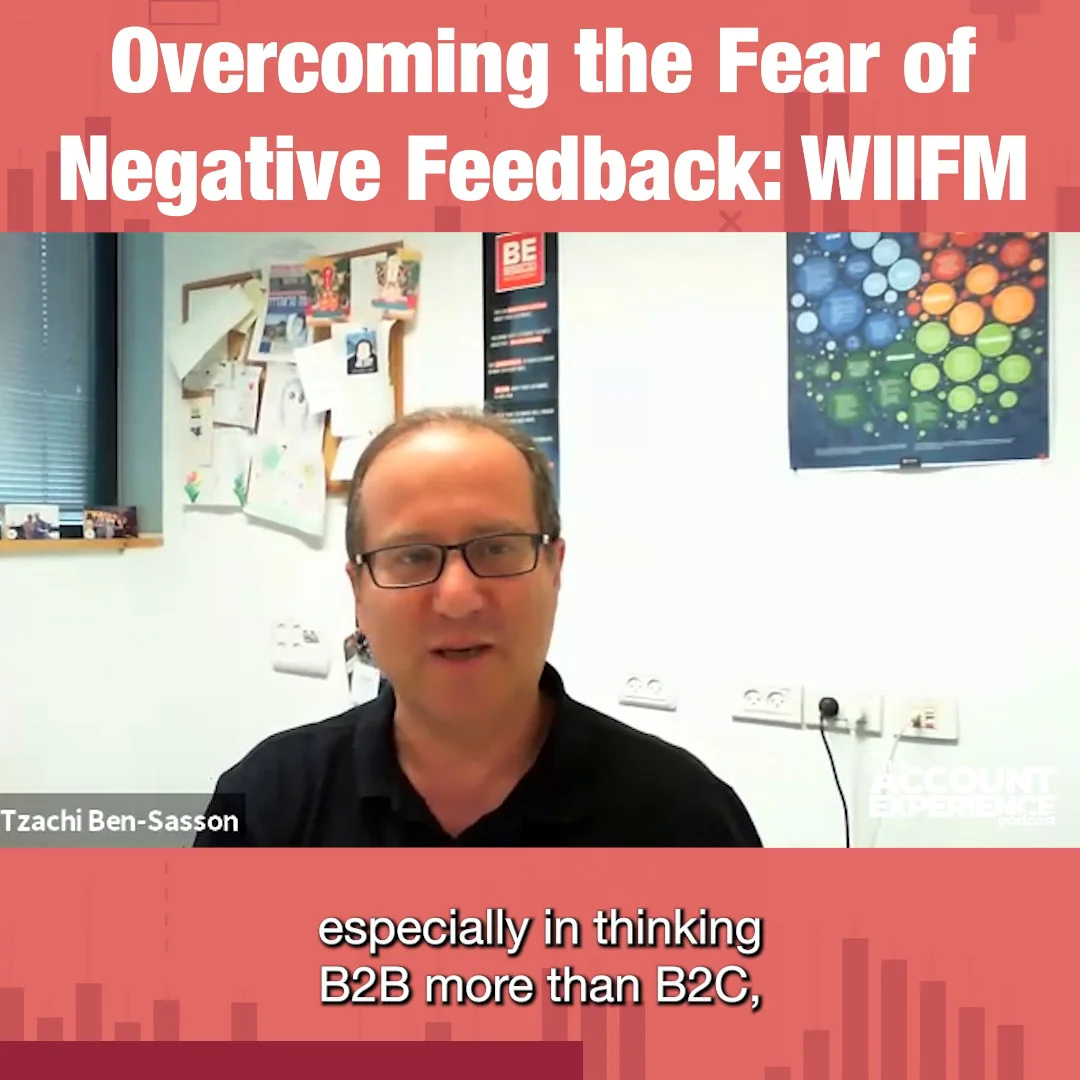CX professionals know that collecting feedback from customers is critical to improving the customer experience, tracking satisfaction and retention rates, and even predicting future revenue.
But getting buy-in for a customer feedback program isn’t always easy—especially from chief executives.
This week on the Account Experience podcast, we sat down with organizational psychologist, Tzachi Ben-Sasson of Amdocs—a multinational, NASDAQ-listed telecommunications company with a 30-year history, over 27,000 employees, billions in revenue, and customers in over 85 countries (including massive accounts like AT&T, T-Mobile, and Vodaphone).
Ben-Sasson’s role as an organizational psychologist means that he has unique insight into how employees–including C-suite execs–think, feel, and behave at work. In other words, Ben-Sasson knows how to get enthusiastic, cross-departmental buy-in for critical initiatives (like collecting customer feedback).
The silver bullet to getting buy-in? WIIFM! Recognize that your C-suite execs are asking one critical question–what’s in it for me?
Proving Value to C-Suite Execs
Any CX professional knows that getting feedback is a keystone of providing a great customer experience, and ultimately, creating a successful business.
But to head up a successful customer experience program, you need the backing of chief executives. And that, of course, requires time and attention.
Ben-Sasson continues, “When you’re targeting chief executives, you're competing with hundreds of other people that want 30 minutes or an hour of their time.”
In other words, if you’re asking for the attention of chief executives, you’d better have something of value to show and prove. And typically, that value translates to revenue.
“If you're at the C-suite level, you’re asking, can you actually tell me what that means for my revenue and my margins?,” says Ben-Sasson. “For your CEO, money speaks more than words or psychology. You should be able to show how feedback can ultimately drive the top and bottom line.”
Ben-Sasson continues, “You’ve got to be able to show how customer feedback can shape behavior and drive revenue.”
Telling the Right Story
Next, if you’re going to engage C-suite execs and tie customer feedback back to hard metrics, you’ll want to be able to tell the right story.
“You can't just rest on your laurels and say, Hey, you know, I have this graph from a year ago that shows how nicely our metrics can predict future revenue,” says Ben-Sasson.
“You need to show an account where you got feedback on a product, a project, or individuals. You need to be able to show how they responded to feedback, and how it actually helped them identify business opportunities.”
New business opportunities could include identifying how certain factors seem to boost loyalty (i.e. frequent engagement), or how customers on the verge of churn might be saved by reaching out to them in real-time.
For example, you might tell the story of an account that provided negative feedback or showed signs of churn. After collecting this feedback and responding in real time, a CX team was not only able to salvage the situation, but develop a stronger customer relationship. The result? A saved account (and revenue) and potentially, a boost in reputation.
At the end of the day, it’s not just about immediate revenue. It’s about looking ahead, planning for the long-term, and creating a plan that will create lasting success.
“We try to connect the dots for management. We show them the bigger picture, and not just from a revenue perspective,” says Ben-Sasson. “Revenue is important, but you also need to think of your long-term.”
Collecting Feedback from the Right Customers
If you’re going to focus on getting buy-in from C-suite executives for collecting customer feedback, then you’ll want to make sure that you’re getting feedback from the right people.
“How do you act and actually manage to listen to everyone you need to?” says Ben-Sasson. “The fact that you deal with one or two or 50 people does not mean that there aren’t 500 additional people that have a lot of stake in what you do.”
Part of the challenge is also collecting feedback not just from the right companies, but from the right customers.
“In our industry, the usual suspect would be the IT tower–the CIO or the CTO,” says Ben-Sasson. “But in procurement marketing and digital, it's an always-evolving world. So we definitely try to have a good feel of who the people are that we want to get feedback from.”
Of course, once you collect feedback, it’s critical to quickly close the loop.
“There’s an hourglass that flips after getting the feedback,” says Ben-Sasson. “You can’t just put the feedback into an Excel spreadsheet and PowerPoint presentation, and forget about it.”
“You’ve got to immediately get back to the customer, close the loop, and work with them on an improvement plan. That’s engagement. That's walking the talk.”
Getting Buy-In, Proving Value, & Closing the Loop with Account Experience
CustomerGauge’s Account Experience program allows you to achieve all of the above–and more–by:
Tying customer feedback and NPS score directly back to revenue–giving you powerful leverage for C-suite execs...
Alerting you to “at-risk” accounts ...
Creating a channel for ongoing communication and engagement with your accounts...
And giving you rich insight into why accounts are satisfied, dissatisfied, enthusiastic, or somewhere in between.




